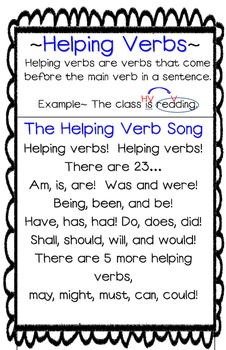
The modal verbs are included in this class, due to their behavior with respect to these diagnostics.Ī list of verbs that (can) function as auxiliaries in English is as follows: be, can, could, dare, do, have, may, might, must, need, ought, shall, should, will, would They list auxiliary verbs, then present the diagnostics that motivate this special class (subject-auxiliary inversion and negation with not). The following sections consider auxiliary verbs in English. Main article: English auxiliaries and contractions There has also been a study on auxiliary verb constructions in Dravidian languages.

In French, for example, verbs such as devoir (have to), pouvoir (be able to), aller (be going to), vouloir (want), faire (make), and laisser (let), when used together with the infinitive of another verb, can be called semi-auxiliaries.
#Helping verbs list with examples full#
In some cases, verbs that function similarly to auxiliaries, but are not considered full members of that class (perhaps because they carry some independent lexical information), are called semi-auxiliaries. In the case of English, verbs are often identified as auxiliaries based on their grammatical behavior, as described below. Modal verbs may or may not be classified as auxiliaries, depending on the language.

– is serves as a copula with a predicative expression not containing any other verb.ĭefinitions of auxiliary verbs are not always consistent across languages, or even among authors discussing the same language. In some treatments, the copula be is classed as an auxiliary even though it does not "help" another verb, e.g., Widely acknowledged verbs that can serve as auxiliaries in English and many related languages are the equivalents of be to express passive voice, and have (and sometimes be) to express perfect aspect or past time reference. The auxiliary verbs of a language form a closed class, i.e., there is a fixed, relatively small number of them. The auxiliary is said to "help" the infinitive. They generally appear together with an infinitive. Auxiliaries like these typically appear with a full verb that carries the main semantic content of the clause.Īuxiliary verbs typically help express grammatical tense, aspect, mood, and voice. These auxiliaries help express a question, show tense/aspect, or form passive voice.

– être, from which sommes is inflected, 'be' is an auxiliary used to build the passive voice in French. I have seen the sun = 'I have seen the sun/I saw the sun.' g. – avoir, from which ai is inflected, 'have' is an auxiliary used to build the perfect tense/aspect in French. She is to home gone = 'She went home/She has gone home.' f.

– sein, from which ist is inflected, 'be' is an auxiliary used with movement verbs to build the perfect tense/aspect in German. That became many times said = 'That was said many times.' e. – werden, from which wurde is inflected, become is an auxiliary used to build the passive voice in German. (I) have grabbed your pencil = 'I have taken your pencil.' d. – he is an auxiliary accompanying the infinitive coger, used here to form a verb phrase, the perfect present in Spanish. – have, from which has is inflected, is an auxiliary used in expressing the perfect aspect of give. Do you want tea? – do is an auxiliary accompanying the infinitive, want, used here to form a question – see do-support.


 0 kommentar(er)
0 kommentar(er)
